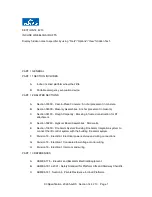
AdvenChair Field Guide
Page 20
usually acts as the chief scout and directs the speed and decides when to stop progress
for discussion of upcoming trail conditions.
b.
Front Mule
: On steep uphill sections, one to four
front mules may assist the lead mule pull the chair up
the hill with towing straps.
c.
Rear Mule
: On steep downhill sections, one or two
rear mules stand behind the driver holding straps
attached to the back of the AdvenChair. They exert a
backwards force on the chair to help with braking and
steering.
d.
Side Mule:
i.
On sections of trail across side slopes, side mules can be deployed with towing straps
on the uphill side of the chair to keep the chair from rolling over.
ii.
On rough sections of the trail, side mules lift the chair up and over obstacles (e.g.
roots, rocks, logs, or stairs and waterbars).
This is most common on uphill trails, but
may also be needed on rough flat or downhill trails or on side-sloped trails.
Safety
AdvenChair hiking is about the journey. As with any outdoor activity, continually evaluate the
weather and terrain and be ready to change plans or return home early if conditions are not
safe. Safety issues specific to AdvenChair hiking include:
1.
Understand your route.
Very easy routes, in town or on paved or wide, firm trails, can be
undertaken with a rider and driver. Difficult routes with steep hills and rough, irregular
trails require a larger, experienced crew. Scout ahead on the route; match the crew to the
route and be prepared to alter the route or turn back depending on conditions..
2.
Communicate
. The lead mule has the best view of what’s coming and should let the driver
and other team members know what’s ahead. Often the driver can’t see the trail directly in
front of the chair and needs advice about how to straddle or steer around obstacles. On
rough trails, the team needs to coordinate how to get through difficult sections. In these
situations, casual conversation, usually encouraged, should stop and the team should focus
on the obstacle, safety, and problem solving.
3.
Don’t be in a hurry.
If the trail gets rough, slow down and adjust. Don’t barrel through
difficult sections to show how competent you and the equipment are.
4.
Downhill hiking.
a.
On a rough trail, downhill hiking is often the most difficult for getting around or over
obstacles. Slow down and configure the team for the situation.
Mules are reputed to be more
patient, hardy and long-lived
than horses and are described
as less obstinate and more
intelligent than donkeys.
--Wikipedia
















































